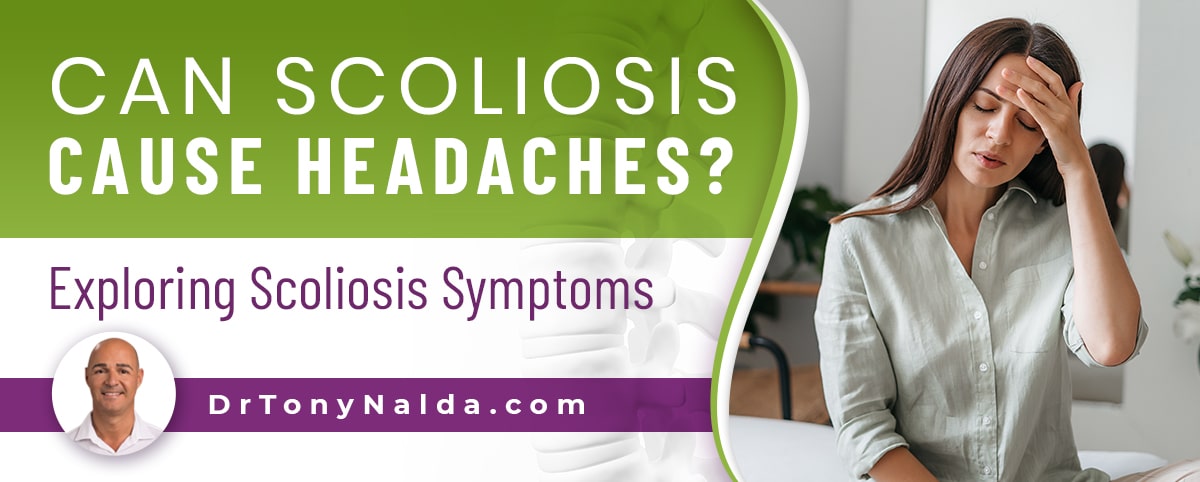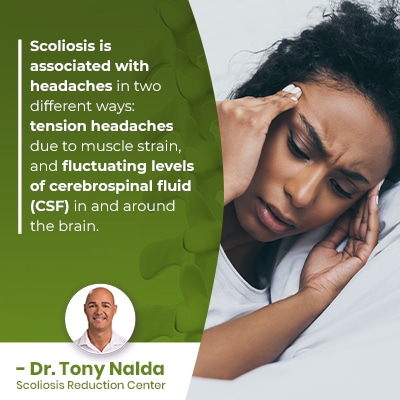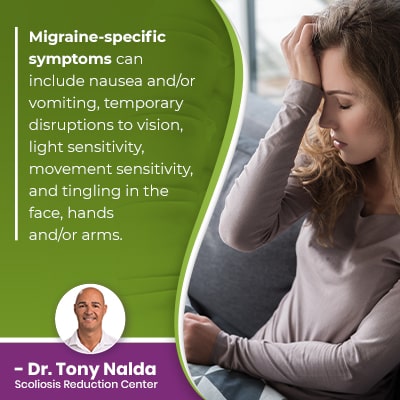Can Scoliosis Cause Headaches? Exploring Scoliosis Symptoms

Scoliosis is a highly-variable condition that ranges widely in severity, has different types that can develop, and can affect all ages. While postural deviation is the main symptom in adolescents, pain is the main symptom of scoliosis in adults, but both can experience condition-related headaches, especially if scoliosis is left untreated.
Each case of scoliosis is unique; symptoms will depend on a number of key patient/condition variables. Scoliosis is associated with headaches, which can include tension headaches due to muscle pain and/or migraines caused by disruptions to the flow of cerebrospinal fluid.
Before getting to the specifics of condition-related headaches, let’s talk about the role of the spine, in general, and what it means to be diagnosed with scoliosis.
Table of Contents
What Does the Spine Actually Do?
The spine is an integral part of human anatomy, and this is because of the important roles it plays in maintaining overall health.
The spine’s health and function impacts the body in many ways; not only does it help us to stand upright and practice good posture, it facilitates flexible movement, and dictates the function of the central nervous system and the body’s internal organs.
The many roles the spine plays in the function of the body, its systems, and its individual parts, makes the spine a main player when it comes to maintaining overall health and wellness.
How the Spine Facilitates Movement
The very design of the spine is based on movement and gives the body structure, support, and balance.
The spine’s vertebrae and intervertebral discs combine forces to enable flexible movement such as walking, bending, twisting, and facilitates a wide range of motion.
The stronger and more flexible the spine is, the more easily a person will be able to move.
The Spine and the Central Nervous System
The spine and brain work in tandem to form the body’s central nervous system (CNS), which is involved in the function of virtually every working system within the body.
The spine also provides protection for the spinal cord within, which is a column of nerves that connects the brain to the rest of the body to facilitate brain-body communication.
The CNS controls general movement, reflex response, organ function, and the mind through a complex communication network that sends messages to and from the brain and the rest of the body.
The brain is the seat of our thoughts and mental health, and it controls how individuals interpret their external environment with internal responses.
For a more comprehensive understanding of spinal health and function, plus how it’s affected by scoliosis, let’s briefly explore the basics of spinal anatomy.
Anatomy of the Spine
The spine has three main sections, and scoliosis can develop in any of them: cervical (neck), thoracic (middle/upper back), and lumbar (lower back).
If you look at a healthy spine from the sides, it will take on a soft ‘S’ shape, and when viewed from the front and/or back, it will appear straight; this is due to the spine’s natural lordosis (inward curves) and kyphosis (outward curves).
The spine’s natural and healthy curves are key to maintaining spinal health, function, and alignment.
The spine consists of vertebrae (bones) that are stacked on top of one another in a straight and neutral alignment, and if the spine loses one or more of its healthy curves, the spine is no longer aligned as it should be, which affects how it functions and disrupts its biomechanics.
So now that we understand why the spine, and its natural and healthy curves, are so important, let’s explore how scoliosis affects it, and the rest of the body, in terms of scoliosis symptoms.
Being Diagnosed with Scoliosis
Being diagnosed with scoliosis means an unnatural sideways spinal curve has developed, with rotation, making it a 3-dimensional condition.
In addition, the unnatural spinal curve has to be of a minimum size: Cobb angle measurement of at least 10 degrees.
A patient’s Cobb angle is a measurement taken during X-ray that tells me how far out of alignment a scoliotic spine is and classifies conditions in terms of severity:
Mild scoliosis: Cobb angle measurement of between 10 and 25 degrees
Moderate scoliosis: Cobb angle measurement of between 25 and 40 degrees
Severe scoliosis: Cobb angle measurement of 40+ degrees
Very-severe scoliosis: Cobb angle measurement of 80+ degrees
While each case is unique, generally speaking, the higher the Cobb angle, the more severe the condition, and the more likely it is to cause noticeable symptoms.
When it comes to the condition’s most prevalent form, adolescent idiopathic scoliosis, diagnosed between the ages of 10 and 18, the main scoliosis symptom is postural deviation, such as uneven hips and shoulders, while in adults, the most common symptom is pain.
Scoliosis introduces a lot of uneven forces to the body, and in light of its many important roles, spinal conditions like scoliosis can affect the body in many different ways, headaches included.
Can Scoliosis Cause Headaches?
As mentioned, because the brain and spine form the body’s central nervous system, spinal conditions like scoliosis can cause some surprising symptoms as their effects aren’t just isolated to the back.
So to clearly answer the question, can scoliosis cause headaches, yes, it most certainly can, but just because headaches are a symptom one patient experiences, doesn’t mean it’s an issue all scoliosis patients will face.
 Scoliosis is associated with headaches in two different ways: tension headaches due to muscle strain, and fluctuating levels of cerebrospinal fluid (CSF) in and around the brain.
Scoliosis is associated with headaches in two different ways: tension headaches due to muscle strain, and fluctuating levels of cerebrospinal fluid (CSF) in and around the brain.
Scoliosis and Tension Headaches
Scoliosis most commonly affects the thoracic spine, and can also develop in the cervical and/or lumbar spinal sections.
Tension headaches are most likely to be a symptom with cervical scoliosis; muscle tension is a factor as the muscles of the neck struggle to support the unnaturally-curved spine and the weight of the head.
As the spine’s natural and healthy curves make it stronger and facilitate its even distribution of shock and weight, if the neck’s healthy curve is compromised, it can become excessively straight, disrupting its ability to adequately support the weight of the head.
A shift forward in posture increases the workload on the neck’s muscles that are in charge of supporting the cervical spine; over time, this can cause muscle imbalance, causing the neck muscles to become excessively tight, sore, strained, and cause the development of tension headaches.
Now, if scoliosis is left untreated, as the condition progresses, it’s likely that its symptoms will also escalate, and tension headaches can become more severe and frequent, particularly if the condition causes low cerebrospinal fluid pressure.
Scoliosis and Low-CSF Pressure Headaches
Cerebrospinal fluid is a clear liquid found in/around the brain and spinal cord; it helps protect the brain and spinal cord, which in turn preserves the health and function of the central nervous system.
CSF is housed in the subarachnoid space and ventricular system that’s inside, and surrounds the spinal cord and brain; it fills the ventricles, cisterns, and sulci in the brain, as well as the spinal cord’s central canal.
Cerebrospinal fluid acts as a cushion protecting the CNS, and its cushioning effect protects the spine and brain from injury.
In addition, CSF also removes waste from the brain, which helps preserve the health/function of the central nervous system.
As scoliosis is the development of an unnatural sideways curve in the spine, plus rotation, it can affect the flow of CSF within the spinal cord’s central canal; when this happens, CSF pressure in the brain can drop, which is known to cause debilitating headaches.
Now, while many people think headaches and migraines are the same thing, they are quite different, so let’s move on to addressing whether or not scoliosis can also cause migraines.
Can Scoliosis Cause Migraines?
While those who suffer from migraines know they are far more than an average headache, those who have yet to experience one might think they’re the same.
An average headache is defined as pain in the head that can cause feelings of discomfort/pressure.
Headaches can develop on one side of the head, or both, and can affect the forehead, temples, and the back of the neck.
A typical headache can last anywhere from 30 minutes, to a number of days, or can come and go intermittently.
Headache triggers will vary from person to person and can include stress, muscle strain, tension, and anxiety.
A migraine is a type of severe headache that tends to last for longer periods of time than average headaches, and is accompanied by migraine-specific symptoms.
 Migraine-specific symptoms can include nausea and/or vomiting, temporary disruptions to vision, light sensitivity, movement sensitivity, and tingling in the face, hands and/or arms.
Migraine-specific symptoms can include nausea and/or vomiting, temporary disruptions to vision, light sensitivity, movement sensitivity, and tingling in the face, hands and/or arms.
Most often, migraines affect one side of the head more, but they can also be felt on both sides.
So how do migraines differ from average headaches? Migraines tend to last far longer, and for some individuals, can last for days and disrupt the ability to maintain gainful employment.
Migraines also affect a person's ability to move without pain.
Many people who suffer from migraines describe warning signs, sometimes hours, or even days before the onset of a migraine; these commonly include a visual disturbance, such as seeing a colorful aura that can look like dancing colorful lights, or a flicker of lights in the periphery.
Additional common warning signs can include a hole in the visual field and numbness and/or tingling in the hands and/or face, and some migraine sufferers also describe feelings of confusion, an inability to remember basic information, such as one’s phone number, disruptions to speech, and feeling overly emotional.
So scoliosis is associated both with regular headaches, and migraines, either due to muscle tension, or low CSF pressure in and around the brain.
Conclusion
With a condition as complex and highly variable as scoliosis, symptoms will vary from patient to patient.
Important patient/condition variables such as patient age, curvature location, condition type (cause), and severity will shape a person’s experience of life with their condition, which is why these variables are also the condition’s classification points.
Following a diagnosis, conditions are further classified based on key factors, not only to streamline the treatment process, but also to guide the crafting of effective treatment plans.
While some patients experience headaches and/or migraines caused by their condition, that doesn't mean that everyone will; for those that do, headaches and migraines are caused by muscle tension and/or disruptions to the flow of cerebrospinal fluid in and around the brain.
When it comes to treatment for condition-related headaches, the best approach is to address the underlying cause of the headaches: the scoliosis itself.
Here at the Scoliosis Reduction Center, I combine multiple treatment disciplines so conditions can be proactively impacted on every level, and as a curvature reduction is achieved, this restores the spine’s healthy curves and alignment, which improves muscle tension and fluctuating levels of CSF.
Dr. Tony Nalda
DOCTOR OF CHIROPRACTIC
After receiving an undergraduate degree in psychology and his Doctorate of Chiropractic from Life University, Dr. Nalda settled in Celebration, Florida and proceeded to build one of Central Florida’s most successful chiropractic clinics.
His experience with patients suffering from scoliosis, and the confusion and frustration they faced, led him to seek a specialty in scoliosis care. In 2006 he completed his Intensive Care Certification from CLEAR Institute, a leading scoliosis educational and certification center.
About Dr. Tony Nalda
 Ready to explore scoliosis treatment? Contact Us Now
Ready to explore scoliosis treatment? Contact Us Now





